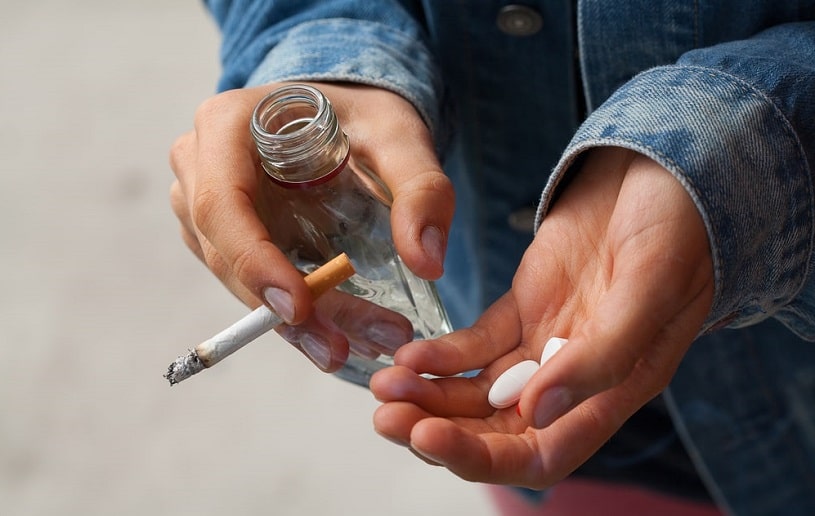Addiction to opioids is a dangerous condition that affects millions yearly, and it causes a massive loss of lives and property. One of the deadliest addictions to experience is Oxycodone addiction. This drug has been abused by millions of people worldwide, and its effects are devastating. That said, this article will help to highlight several facts about Oxycodone addiction.
Table Of Contents:
What Is Oxycodone?
Simply put, Oxycodone was a drug initially created to reduce pain in individuals. However, this medication is potent and addictive. It is also one of the contributors to the US opioid epidemic.
What is Oxycodone used for? This drug is mainly taken by patients with severe pain due to conditions like cancer, arthritis, kidney stones, etc.
It also works as a depressant on the nervous system. It slows down the rate of breathing, heart rate, and blood pressure. When used as directed, these effects can work as a sedative to help patients with pain sleep while also reducing the body’s reception of pain. When abused, overdose is a real risk.
Oxycodone Drug Class
The Oxycodone drug class comes from a class of drugs known as opioid analgesics. The medication is commonly used by people to treat several forms of pain and is sold by several pharmacies. Although a prescription is required to purchase this drug, people can often obtain it through unorthodox methods. The Oxycodone drug class is safe for usage, provided it is taken with a prescription.
Is Oxycodone Addictive?
Yes, OxyContin is a very addictive drug when used in the wrong way. As mentioned previously, it was created to address specific forms of pain. However, people have started using it for recreational purposes.

More About Opioids:
It also belongs to the opioid family, which many studies have proved to be highly addictive. OxyContin addiction occurs rapidly by triggering the body’s production of endorphins upon taking this opioid. Although it sharply reduces pain, recreational consumption also abnormally boosts feelings of happiness. Due to wanting more of that feeling, individuals often get OxyContin addiction after a few uses of this medication.
Consumption of this opioid recreationally provides both euphoric and sedative feelings, which only leaves individuals wanting more. So, for people asking, “is Oxycodone addictive?” Yes, it is.
Abuse Statistics
The use and abuse of this opioid are widespread and affect more people than one might imagine. It is one of the most commonly used pain medications available alongside Hydrocodone, with more than 32 million Percocet prescriptions being written each year alone.
It also contributes significantly to the mortality rate each year.
About 47,000 people in the United States alone die due to an overdose of opioids.
Additionally, the United States economy often records a loss of 78.5 billion a year due to emergency room expenses, loss of productivity, and so on.
Dangers of Abuse
As stated earlier, this medication causes dangerous side effects of Oxycodone when consumed the wrong way. The most common method of misuse is oral consumption of the Oxy pill.
However, some reports state that individuals now crush the pill to snort Oxycodone. Others grind the pill and make it a mixture to ease injection into the bloodstream. Undoubtedly, these are all dangerous methods of consuming the medication, as they can cause severe damage to the brain and body within just a few months.
That Said, Here Are the Dangers of Abusing This Opioid:
Addiction
Many users of this opioid tend to think that occasional use would prevent Oxycodone addiction from occurring. However, this couldn’t be more wrong. Even occasional use can lead to a crippling addiction and immense damage to health.

As is popularly known, addiction is a dangerous condition that ruins the lives of many and harms their health. Affected individuals tend to withdraw from routine activities and overall social activities. Unfortunately, deciding to stop would also come with life-threatening OxyContin withdrawal symptoms.
Overdose
Though it is unnecessary to have an addiction to overdose, abusers of this opioid are much more inclined to it because they have likely built up a tolerance, which means they have to take more of the drug to feel the same effects.
Normally, Oxy taken in small amounts poses no threat. In fact, it even helps the body fight off all sorts of pain. However, large doses (more than 100 mg) of Oxy cause overdose. The first symptom of Oxy overdose is breathing difficulties, and loss of awareness closely follows.
Abusing Other Drugs
Many opioid users first start with prescription opioids and then switch to illicit substances. According to NIDA, about 80% of people who use heroin first misused prescription opioids like OxyContin. Addicted individuals often switch to heroin because it provides similar effects, and obtaining Oxy is quite challenging. On the other hand, heroin is a street drug that addicts can find easily. In addition, addicted individuals can use Oxycodone in combination with alcohol.
OxyContin and heroin have similar effects; therefore, both drugs are attractive to the same abuser population. OxyContin is sometimes referred to as “poor man’s heroin.The Department of Justice in the United States reports
Signs of Oxycodone Addiction
Oxy users frequently undergo behavioral changes. One begins to display a detachment about the body and surrounding environment. Oxycodone addiction signs affect the mind where the user feels life is too challenging without regular use of Oxy. Addicts seek out that initial euphoric feeling, and through constant use, will develop a tolerance to the drug. It ultimately leads to physical dependence and damage to health. Mental health disorders often surface.
Users Exhibit the Following Psychological Symptoms of Oxycodone Addiction:
- Withdrawal from routine activities
- Half-hearted attempts at quitting Oxy
- Obsessing over the next fix
- Unable to think clearly or carry out simple tasks
- Scattered memory
- Development of mental health disorders
- Unable to process new information
- Paranoid or secretive behavior
- Hostility when questioned about activities or lack thereof
- Hallucinatory episodes and disorders
The need to maintain the high overtakes every instinct of self-preservation. Through sharing needles to the user being exposed to dangerous situations, goals and priorities are diminished or fade into oblivion. Obtaining Oxy is all that matters.
Physical Symptoms
Symptoms of OxyContin abuse can be mistaken for a typical hangover if one is unfamiliar with the signs.
Oxy Addiction Symptoms Include the Following:
- Problems with inhaling and exhaling
- Intense physical cravings
- Sweating
- Drowsiness
- Weak sensations
- Loss of physical awareness
- Deterioration of health
- Addiction to other substances like alcohol
- Development of eating disorders
One may also observe signs of opioid use in the user indulging in violent or criminal behavior like theft, muggings, or robberies. Physical evidence of drug abuse may be present, e.g., bottles of pills, discarded syringes, combined use with alcohol, burnt spoons or pieces of foil, etc. If users are inhaling the drug, a crushing device may be present. For instance, kitchen equipment like a mortar-and-pestle comes in handy.
Treatment for Addiction to Oxycodone
The treatment of Oxycodone addiction is a complicated integration of therapies. Because Oxycodone withdrawal symptoms are so severe and can even be fatal, it is highly recommended that users do not attempt to wean off the drug without medical supervision. Many factors determine how long Oxycodone stays in the body. Having doctors and other professionals on hand to monitor and treat any symptoms ensures that patients are kept safe from potentially lethal reactions.

Once the detoxification phase of treatment is complete, patients should be given intensive therapy to help them learn new coping mechanisms – both for resisting cravings and temptations-and handling any stress, grief, or trauma that may have contributed to their drug use in the first place. In addition, doctors should offer alternative pain alleviation techniques to those with a medical condition for which Oxycodone hydrochloride is commonly prescribed. These addiction treatment methods and therapies are best provided in an inpatient facility equipped with addiction specialists.
Once patients have completed their rehabilitation program, medical professionals will offer ongoing support and counseling. They will also monitor affected individuals to ensure abstinence from alcohol and other substances.
If someone is struggling with addiction to Oxycodone hydrochloride, know that there is help available. With the proper treatment, there is hope for recovery.
Frequently Asked Questions
What Is the Shelf Life of Oxycodone?
The expiry date for Oxycodone chloride depends on its manufacturers. Different manufacturers have different ways to process the constituents of this opioid, hence the fluctuation in shelf life. The shelf life is often measured using stability testing, which the Food and Drug Administration of a particular company determines. That said, its shelf life usually ranges between a year to three years.
Is Oxycodone an Opioid?
Yes, this opioid is a drug that belongs to the opioid family. Some other examples of opioids are heroin which is made illegally, and fentanyl which is synthetic. The brain and body contain several dormant opioid nerve cells that get triggered upon consumption of this substance.
Does Oxycodone Have Tylenol in It?
No, this opioid does not naturally contain Tylenol. However, many manufacturers choose to combine this drug with Tylenol. Acetaminophen combination with Oxycodone hydrochloride has helped millions of people worldwide relieve severe pain conditions. This opioid affects your brain, dulling its response to pain, and Acetaminophen helps maintain homeostasis by regulating temperature. However, before you start taking any of these medications, make sure you consult your doctor.
Hope Without Commitment
Find the best treatment options. Call our free and confidential helpline
Most private insurances accepted
Page Sources
- National Institute on Drug Abuse, what are prescription opioids, 2013. https://www.drugabuse.gov/publications/drugfacts/prescription-opioids
- CBHSQ Data Review, Associations of Nonmedical Pain Reliever Use and Initiation of Heroin Use in The United States, 2013. https://www.samhsa.gov/data/sites/default/files/DR006/DR006/nonmedical-pain-reliever-use-2013.htm
- Ricardo Buenaventura, M., Rajive Adlaka, M., & Nalini Sehgal, M. (2008). Opioid complications and side effects. Pain physician, 11, S105-S120. https://pubmed.ncbi.nlm.nih.gov/18443635/
- Center For Disease Control and Prevention, Opioid Basics, 2021. https://www.cdc.gov/opioids/basics/index.html
- Department of Health and Human Services, What Are Opioids? 2020 https://www.hhs.gov/opioids/treatment/index.html
- Illinois Department of Public Health, Prescription Opioids and Heroin, 2019. https://www.hhs.gov/opioids/treatment/index.html
- MedlinePlus, Opioid Addiction, 2017. https://medlineplus.gov/genetics/condition/opioid-addiction/
- Riley, J., Eisenberg, E., Müller-Schwefe, G., Drewes, A. M., & Arendt-Nielsen, L. (2008). Oxycodone: a review of its use in the management of pain. Current medical research and opinion, 24(1), 175-192. https://pubmed.ncbi.nlm.nih.gov/18039433/
- Minhas, M., & Leri, F. (2018). A multifaceted analysis of oxycodone addiction. International Journal of Mental Health and Addiction, 16(4), 1016-1032. https://link.springer.com/article/10.1007/s11469-017-9827-y

 Authored by
Authored by  Reviewed by
Reviewed by 


